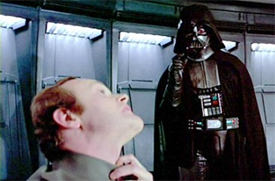When it comes to customer experience, my personal mission has always been crystal clear: help companies act more intelligently. Smart companies leverage disruptive technologies, like social influence and digital sensors, to better serve their customers. Stupid companies ignore them, or use them as tactics disconnected from strategy. Most companies fall into one of these two buckets, or in areas between.
 But there’s a third group out there—companies that are too smart for their own good, or for the good of their customers. And though they may gain ground in the short term, they're hurting themselves as well, though it might take a while to become apparent. One of their tricks? “Dark patterns.” If your firm is using any of these practices, I can guarantee - you're acting stupidly. Read on.
But there’s a third group out there—companies that are too smart for their own good, or for the good of their customers. And though they may gain ground in the short term, they're hurting themselves as well, though it might take a while to become apparent. One of their tricks? “Dark patterns.” If your firm is using any of these practices, I can guarantee - you're acting stupidly. Read on.
What on earth is a “Dark Pattern”?
According to Deceptive Design, a dark pattern is “a type of user interface that has been carefully crafted to trick users into doing things.” Put another way, firms that employ dark patterns trick their customers into buying/signing up for things they almost certainly don't want.
It can be as egregious as getting rental car customers to buy insurance they don't want or need, or signing up for recurring shipments, billed monthly, when all they want is a single purchase. It can be as seemingly innocent and insidious as a request for a cow on Facebook that you don't want, or didn't mean to send.
You get the drift. Dark patterns get customers to do things they wouldn't typically choose to do, if they were presented the options in a straightforward manner. This Slideshare from Harry Brignull has some great examples (and some great advice).
Dark Patterns: User Interfaces Designed to Trick People (Presented at UX Brighton 2010) from Harry Brignull
Four Pied Pipers, Falling Down a Slippery Slope
We’ve observed several common drivers of dark patterns. The first is as old as humanity itself: Greed. The others are typically forms of tremendous market pressure, like:
- Extreme Competition: The travel industry, especially RyanAir (as shown in the slideshare) is notorious for using tricks that let them appear to offer a lower price in a commoditized industry with margins cut to the bone. Of course, users find out the truth a little too late.
- Coming Obsolescence: Given that the entire magazine industry is facing extinction and publishers have to reinvent their revenue stream, it’s not surprising that publishers including Condé Nast have succumbed.
- Short-Lived Opportunities: After Facebook’s eye-popping acquisition of Instagram, there was a huge rush to see who’d be the “Instagram of Video.” Socialcam and Viddy reached 100 million combined users with the help of social-driven dark patterns. Socialcam was acquired by Autodesk, and Viddy raised a huge round of funding. But as of November Viddy was down to 660,000 users. Ooops.
Staying on Your Customers’ Good Side
Companies engage in practices like these for the same reasons that drove the LIBOR price-fixing scandal, securitization of junk debt, or selling mortgages to singularly unqualified homebuyers. They think they’ll make more money – and many do in the short run. But in an increasingly transparent world, the risks to corporate reputation are huge.
Even for execs that care more about short-term profits than customers, the downside risks are huge. In a world of ever smarter, more connected customers, companies that engage dark patterns to shortsightedly meet near-term goals will eventually pay the ultimate price: they’ll slowly fade, losing ground as they lose respect until they eventually disappear.
And if you put the needs of your customers first, you’ll find that the long-term payoffs radically outweigh any short-term gains. Just watch RyanAir or Dollar Rent A Car get pilloried in the press, or see customers bolt from firms like Viddy. It doesn't take a genius to understand that putting customers first is always a better path.
So, ask yourself: does your company ever try to “trick” your customers? If the answer is yes, put up your hand and “out” the practice, pushing your firm to do something, well, better. There’s always an alternative to using dark patterns.
And if you can’t, it’s time to look for a new job.
Because in the new world of smart customers, changing expectations and radically improved experiences, any company that thinks they can fool their customers are fooling themselves.

